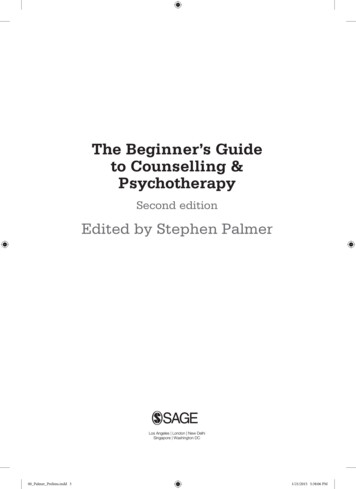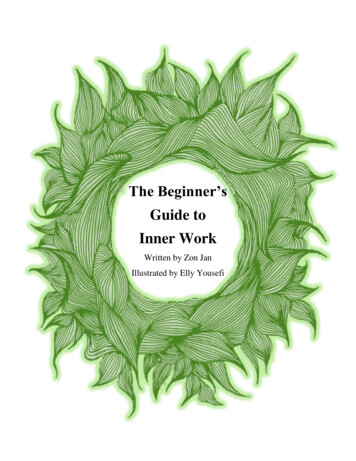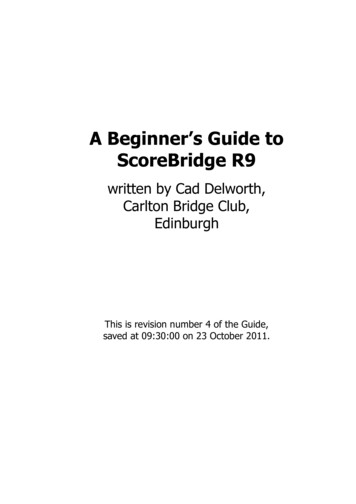
Transcription
The Beginner’s Guideto Counselling &PsychotherapySecond editionEdited by Stephen Palmer00 Palmer Prelims.indd 31/21/2015 5:38:06 PM
1An Introduction toCounselling andPsychotherapyColin Feltham andStephen PalmerIn recent years both counselling and psychotherapy have been demonstrated ontelevision with real clients and discussed on radio programmes. There are numerousYouTube clips illustrating therapy too. So it is very likely most people today probablyhave at least some notion of what counselling is, since the term is now used so widely.However, misunderstandings and disagreements still abound about what the differences are between advice giving, counselling, psychotherapy, coaching, mentoringand similar terms. Although we cannot go into it all here, it is true to say that a wholehost of activities, professions and relationships, from befriending, co-counselling andmutual aid groups, to clinical psychology, counselling psychology, coaching psychology,psychiatry and social work, in some ways resemble and overlap with each other. Inthis chapter we will focus on understandings of counselling skills, counselling andpsychotherapy, before going on to look succinctly at different approaches.COUNSELLING SKILLSTerms such as counselling skills, communication skills, interpersonal or relationshipskills are often but not always used interchangeably. It is sometimes thought thatthere are certain communication and relationship-building skills that all or mostapproaches have in common, and these tend to be skills used intentionally in conversation towards certain helpful ends. Counselling skills may be said to differ fromeveryday, casual conversation in the following ways. While much ordinary conversation is characterized by rather casual, perhaps somewhat inattentive listening, a key counselling skill is active listening, which involvesthe conscious discipline of setting aside one’s own preoccupations in order to02 Palmer Ch-01.indd 41/21/2015 2:44:45 PM
Introduction to counselling and psychotherapy 5concentrate as fully as possible on what the other person is expressing. This mayinvolve a high level of awareness of one’s own prejudices and idiosyncrasies.While ordinary conversation may contain a great deal of interaction, anecdotes,sharing thoughts and ideas and changing the subject aimlessly, another key counselling skill involves the discipline of responding mainly to the other person, in apurposeful, non-judgemental and often rather serious way, which tends to meanthat such conversation usually has a somewhat one-way character.While ordinary conversation is not usually constrained by any agreements aboutconfidentiality, counselling skills are usually backed up by either an implicit orexplicit understanding about confidentiality.While ordinary conversation is often thought to be ‘natural’ and to have no particular rules governing it, counselling skills may often feel or be experienced assomewhat unnatural. For example, the person using counselling skills may striveto understand very accurately and demonstrate this striving by sometimes repeating parts of the other’s statements in order to clarify or deepen understanding.Finally, while much ordinary conversation wanders across many subjects with no necessary goal, counselling skills are generally associated with some sort of goal, be ithelping with decision making, offering an opportunity to discharge emotions, offering alternative interpretations or suggesting strategies for making desired changes.Although there is some disagreement about the extent to which counselling skillsmay be possessed naturally by many people, it is widely (although not universally)believed that the skills have to be identified, understood, learned and practised repeatedly if one is to be able to be a consistently good listener and effective helper. Also, itis important to remember that while skills of this kind may be learned by many professionals, sometimes for their own ends (for example, salespeople intending to wincustomers over), the use of counselling skills is properly associated with therapeutic,helping or healing ends and not with self-centred agendas.Counselling skills may be used in all sorts of situations in the classroom, at a hospital bedside, in training settings, or at bus stops or parties! In other words, they may beused within professional contexts, in voluntary work, or simply in everyday social anddomestic settings, when someone is trying to listen in a disciplined manner, to be ashelpful, constructive or interested as possible. Fairly typically, students on counsellingskills courses may be nurses, teachers, ministers of religion, residential social workersand similar professionals, as well as those engaged in voluntary work. Typical too oncounselling skills courses is some sort of model (three or five stages of the helpingprocess) drawn from the ideas of Gerard Egan (Emeritus Professor of Psychology andOrganizational Studies), Richard Nelson-Jones (Counselling Psychologist), Sue Culley(Counsellor) and others, usually advocating systematic practice in basic and advancedempathy, paraphrasing, summarizing, open questioning, challenging and so on.COUNSELLINGCounselling differs in its formality from interactions where counselling skills are used.Counselling is generally characterized by an explicit agreement between a counsellorand client to meet in a certain, private setting, at agreed times and under disciplined02 Palmer Ch-01.indd 51/21/2015 2:44:45 PM
6Guide to counselling & psychotherapyconditions of confidentiality, with ethical parameters, protected time and specifiedaims. In the past decade the setting has become more flexible, with the advent ofinternet-based therapy websites, and Voice-Over-IP providers such as Skype and VSee.Usually (although not always) the counsellor will have had a certain level of training (beyond the level of a certificate in counselling skills, typically a diploma orabove), will belong to a professional body with a published code of ethics and willreceive confidential supervision for her or his counselling. In some countries statelicensure exists, such as in the USA, which is independent of the professional bodies.(See Appendix 1 for a list of professional bodies.)It is widely accepted that counselling may be a suitable form of help for a varietyof personal problems or concerns, the most common being depression, anxiety, stress,bereavement, relationship difficulties, life crises and traumas, addictions, self-defeatingbehaviour and thwarted ambitions. It can help with issues of loss, confusion andother negative conditions or it may also be used more proactively and educationallyto learn, for example, how to relax, be more assertive, deal with stress and lead a morefulfilling life.It is not essential to know where counselling comes from etymologically, historically and so on, but it probably does help to consider a few facts. The termitself does of course stem from the verb ‘to counsel’, which has always meant toadvise, so it is not surprising that some people still have this misconception aboutcounselling. Although some forms of counselling contain some advice-giving components, counselling is mostly dedicated to enhancing or restoring clients’ ownself-understanding, decision-making resources, risk taking and personal growth.Telling people what to do is therefore usually eschewed as a short-term and oftencounterproductive remedy.Historically, a great deal of counselling in Britain has been associated with thenon-directive, client-centred approach of the psychologist and psychotherapist CarlRogers, and indeed we have to thank Rogers as one of the most active promotersof counselling in the USA. Many early British counsellors, too, took their ideas andtraining from Rogers’ approach which, as we shall see later in this book, rests heavily and optimistically on belief in the innate resourcefulness and goodness of humanbeings. But it is important to know that hundreds of different theoretical approachesto counselling now exist (see Appendix 2), many of which do not share Rogers’views, and some of which may be almost diametrically opposed to Rogers. In somecountries, such as England and Wales, there has been an increasing demand by theNational Health Service (NHS) for counsellors to practise brief cognitive behaviouraltherapy in order to limit therapeutic costs. Counselling can be seen as a very broadand potentially confusing field of learning itself.It may help when you come to consider differing approaches to counselling andpsychotherapy to remember that each is necessarily an imperfect product of a certaintime and place, which in its own way strives to make sense of distress and to promotemethods of effective help. While each approach emphasizes certain aspects of humanfunctioning and therapeutic skills, it has been argued that most depend on commonfactors such as a healing (second chance) relationship, a good fit between client andcounsellor, the readiness of clients to be helped, the belief of clients and counsellorsin the efficacy of counselling, and the plausibility of espoused theories.02 Palmer Ch-01.indd 61/21/2015 2:44:45 PM
Introduction to counselling and psychotherapy7PSYCHOTHERAPYDo not despair or blame yourself if you are confused by the differences betweencounselling and psychotherapy; the alleged differences are indeed confusing and evenmany of the most prominent practitioners disagree. Psychotherapy originally referredto a less intense form of psychoanalysis and is still understood by some professionalsas being, properly speaking, psychoanalytic psychotherapy only. However, the clientcentred or person-centred approach is referred to as both counselling and psychotherapy, usually without distinction. Various forms of brief psychotherapy challengethe simplistic claim that psychotherapy is long term and counselling is brief. It isprobably advisable to ask anyone who uses the term psychotherapy exactly how theyare using it, and with what justification!Most psychotherapy, like counselling, is fundamentally talking-based therapy, resting on psychological contact, theories and techniques. It is ultimately difficult todistinguish between counselling and psychotherapy, and indeed other similar practices.[C1Q1]1 None the less, it is important to accept that some practitioners (mainly thosetrained as psychotherapists) strongly believe in significant differences. Since clients orpotential clients sometimes ask about such matters, it is important in the long run tobecome informed about them.We now outline what we think are the basic differencesas claimed by many psychotherapists. Psychotherapy (and its psychoanalytic variants in particular) involves lengthy training (three to four years and sometimes more) which usually includes ongoing mandatory personal therapy for all trainees, exposing them to the subtle, unconsciouslayers of conflicts and defences they inevitably have. Working through one’s ownunconscious conflicts lessens them, makes it unlikely that clients’ and therapists’issues will become confused or that clients will be intentionally or unintentionallyexploited or abused, and is the best way of experientially understanding the theoryand enhancing the practice of psychotherapy. In some countries’ counselling training, personal/training therapy has recently become mandatory, with counsellingpsychologists and counsellors having to complete at least 40 hours as partialfulfilment of requirements for chartered and accredited status respectively. Psychotherapy addresses the deep, unconscious, long-standing personality andbehaviour problems and patterns of clients (frequently referred to as patients),rather than focusing on and superficially resolving only their presenting symptoms.Psychotherapy is about radical, far-reaching personality change which is likely tobe much more robust than the symptomatic and temporary changes effected bycounselling. Psychotherapy, originally closely associated with the medical profession, takesvery seriously clients’ psychopathology, or entrenched psychological distress patterns, usually thought to derive from very early relationships in childhood and/orfrom partly innate drives. Psychotherapy holds out hope of making real differencesto the lives of some very disturbed or damaged people who could not benefit fromonce-weekly, symptom-oriented or crisis-related counselling. Psychotherapy requires a substantial time commitment, sometimes demandingthat patients attend several times a week for several years. Counselling, by contrast, is often very short term and usually once-weekly.02 Palmer Ch-01.indd 71/21/2015 2:44:45 PM
8Guide to counselling & psychotherapyIt is important to state that such a brief summary risks caricaturing both psychotherapy and counselling. Also, it is true to say that many practitioners do not adoptantagonistic positions such as these, instead agreeing that valuable work is carried onunder different names or that different kinds of work are being usefully carried on bytwo (or more) different professional groups. By examining the literature of the relevantprofessional bodies and related forums for your country or region (see Appendix 1)you may become acquainted with such issues in greater depth if you so choose.APPROACHES TO COUNSELLING AND PSYCHOTHERAPYThere follows a condensed overview of the main approaches to counselling and psychotherapy to be found in this book. The purpose of this admittedly whirlwind touris to encourage readers to: get an overall sense of the field, some of its complexity, its historical and theoretical breadth begin thinking about the key differences between approaches why they differ, howthe differences are of interest and use, and how they are perhaps not so useful begin to consider what the main, common effective ingredients of the approaches may be ask themselves why they may be especially attracted to some approaches morethan to others, and on what grounds.Given that this is a highly complex and controversial field, you are cautioned thatwe, like all practitioners, are likely to have our own biases and limitations in understanding. The positive value of a book such as this is that it condenses and representsmultiple theories and practices in a manageable format. If you intend to look moredeeply into the intricacies of particular approaches and the debates between counsellors, it is usually advisable to refer both to traditional literature (original sources) andto the latest editions of specialist texts by those representing their own theoreticalorientation. We have arranged this overview according to the convention of psychodynamic/psychoanalytic, cognitive behavioural, humanistic-existential traditions,integrative and eclectic, and lastly the constructivist approaches. This reflects theorder in which the therapeutic approaches are arranged in the sections of the book.PSYCHODYNAMIC AND PSYCHOANALYTIC APPROACHESPsychoanalysis was the creation of the physician Sigmund Freud at the end of thenineteenth century. Many of Freud’s early adherents split from him for theoretical andpersonality reasons, and many psychoanalytic approaches have evolved from Freud’sin recent decades. The terms psychoanalytic, analytic, dynamic, psychodynamic anddepth psychological may be said to share a stake in belief in the existence and powerof the unconscious dimension of the mind, with its complex conflicts, symbolisms02 Palmer Ch-01.indd 81/21/2015 2:44:45 PM
9Introduction to counselling and psychotherapyand defence mechanisms; in the importance of early childhood development andits long-standing effects; and in the replay of unconscious forces in the therapeuticrelationship in various kinds of transference phenomena. Critics suggest that theseapproaches may be elitist, expensive, ineffective and based on implausible theories.However, we would prefer readers to keep an open mind and this book allows thereader to find out more about each approach or school of therapy.AdlerianAlfred Adler, a physician, had also been a colleague of Freud before launching his own‘individual psychology’ around 1912. Adler disputed Freud’s emphasis on psychosexual development and instead stressed the importance of a holistic view, incorporatingthe social and educational dimensions. Adler examined issues of power in families,particularly in sibling relationships, faulty private logic leading to mistaken life goals,and many other phenomena. Sometimes criticized for being too akin to commonsense (and therefore arguably not psychoanalytic), Adlerian therapy or counselling hasalso been claimed by some (for example Albert Ellis) as influential in the developmentof cognitive behavioural therapy.FreudianSigmund Freud is probably regarded by a majority of counsellors as the single mostsignificant founding figure in the development of counselling and psychotherapy.Although some now argue that there is no truly current Freudian therapy (becauseother variants have incorporated and bettered Freud), we must credit Freud with aparticular view of a complex unconscious system made up of innate drives as wellas early developmental vulnerabilities. Freud’s concepts of ego, id and superego, hisidentification of defence mechanisms, insistence on the unconscious significance ofdreams, jokes and slips of the tongue, on the importance of working through transference material in therapy, and other contributions have had an enormous influence oncounselling and on popular culture.JungianAt one time very close to Freud, the psychiatrist Carl Jung established his own ‘analytical psychology’, or Jungian analysis (although he was not happy with the latterterm), from the early part of the twentieth century. Jung disagreed with Freud’s stresson childhood as the seat of all later ills, gave due weight to adulthood and old ageand the complexity of the psyche, and focused on a lifelong process of individuation. Jung was influenced by mythology, anthropology, theology, astrology, alchemyand other disciplines, advocated a collective as well as an individual unconscious, andintroduced many non-Freudian techniques. Modern Jungian therapy has its ownschools of developmental, archetypal and classical therapy and is sometimes considered a transpersonal (spiritually oriented) approach.02 Palmer Ch-01.indd 91/21/2015 2:44:45 PM
10Guide to counselling & psychotherapyKleinianMelanie Klein, psychoanalyst, represents a second or possibly third wave of psychoanalytic development, dating from around the 1920s and 1930s. Klein was more interestedthan Sigmund Freud in infant observation, in inferences about the long-standing influence of early relationships (‘object relations’) and in formulating developmental stagesaligned with vulnerable early relationships with primary caregivers. She also developedmethods of child psychotherapy and theory, and practice relating to psychoses. Klein,who developed much of her work in Britain, was affiliated with the object relationsschool whose therapeutic work is characterized by a belief in the inevitable replay ofpowerful, damaged early states as unconsciously driven reactions towards the therapist.COGNITIVE BEHAVIOURAL APPROACHESHistorically, behaviour therapy pre-dates the cognitive therapies and these may be seenas quite distinct from each other. However, in the last few years a kind of merger hasbeen tacitly acknowledged. Behaviour therapy, stemming from psychological sciencein the 1920s and clinical psychology in the 1950s (in the UK), is based on an attemptto produce scientific therapy by observing problematic behaviour accurately, generating testable theories and robust and effective remedies. Broadly speaking, it is abouteliminating or reducing distressing behaviour and is not concerned with alleged causesor global personality changes. With the cognitive dimension comes the recognitionof certain mediating thought processes between behaviour and distress. The cognitivebehavioural approaches seek to assess and treat identified symptoms and concerns in anefficient, largely here-and-now, verifiable manner, using precise assessment techniques,and a range of in-session and homework-based tasks. A key strategy is to restructureand modify unhelpful thoughts and beliefs. However, a new generation (sometimesknown as ‘third wave’) of cognitive behaviour therapies have been added to the family. These include acceptance and commitment therapy or ACT, compassion focusedtherapy (CFT) and dialectical behaviour therapy (DBT). These new approaches focusless on restructuring beliefs and more on encouraging the clients not to be judgementalabout their cognitions and feelings – just to accept them as beliefs and not facts. Thishas been an interesting development and has seen mindfulness training increasinglyused as an intervention within these new approaches.Acceptance and commitment therapyAcceptance and commitment therapy (ACT) is part of the ‘third wave’ of cognitivebehavioural therapies. In conversation and in the literature it is usually shortened to‘ACT’, pronounced as a single word ‘act’. ACT was developed by Steven C. Hayesand associates during the 1980s. It is informed by relational frame theory, whichis a theory of language and cognition. ACT is described as a ‘contextual’ cognitive02 Palmer Ch-01.indd 101/21/2015 2:44:45 PM
Introduction to counselling and psychotherapy11behaviour therapy (CBT) as it attempts to alter the psychological context of a client’sinternal experience. So rather than challenging unhelpful beliefs, as occurs in CBT,ACT takes a mindful approach to them instead so that the client can find them lessdistressing. In addition to the application of mindfulness to be present in the moment,the ‘Defusion’ technique clearly illustrates this process. It involves clients repeatingpainful phrases or words until they become just sounds, not attached to distressingoverwhelming memories.Behaviour therapyStemming from a number of countries and pioneers, behaviour therapy set out to promote a scientific theory of behaviour, behavioural problems and their remedies, without recourse to gratuitous and unprovable concepts. We learn unhelpful behaviours(by using faulty ways of dealing with stress, by always responding with panic to certainsituations, for example) and proceed to reinforce our unhelpful behaviour. Behaviourtherapists identify precise situational factors associated with problem behaviours andteach coping and social skills, systematic desensitization (gradual exposure to what wefear, while learning to relax) and response prevention (learning not to keep checkingelectrical appliances, for example, as in obsessive–compulsive disorder). It is said tobe especially successful with phobias, obsessive–compulsive problems and other wellspecified conditions.Cognitive behavioural therapyAaron Beck, psychiatrist and psychotherapist, developed cognitive therapy from the1950s, in an attempt to improve upon psychoanalytic methods. Noting that we frequently appear to have automatic thoughts about our circumstances and that we makemany incorrect inferences about our situation that may both create and worsen negative moods, Beck successfully applied his findings initially to depression. In more recentyears there has been a gradual integration of cognitive and behaviour therapies andit has become known as cognitive behavioural therapy (CBT). The approach is basedon collaboratively helping clients to understand how their own cognitions (thinking)affect their moods and behaviour, and how certain common lifelong belief patternscan be overthrown methodically. CBT is becoming widely available in many countriesdue to the research highlighting its effectiveness with a wide range of disorder.Compassion focused therapyCompassion focused therapy (CFT) is an integrated and multimodal approach thatis informed by a number of key areas: evolutionary, neuroscience, social, Buddhistand developmental psychology. The multimodal aspect is reflected by the interventions, which include Socratic questioning, behavioural experiments, guided imagery,02 Palmer Ch-01.indd 111/21/2015 2:44:45 PM
12Guide to counselling & psychotherapychair work, mindfulness, method acting and expressive writing. Over 25 years agoa psychologist, Paul Gilbert, noted that some clients with complex mental healthproblems could understand the logic of the questions he asked them in order toexamine their unhelpful thinking but the CBT style of questioning did not changehow they viewed themselves. Gilbert started to encourage clients to develop an innerwarm voice, but some clients who were experiencing shame and who were highlyself-critical encountered great difficulty in this exercise. In the past 25 years, Gilbertand his associates have developed CFT to assist clients with these type of problems.Dialectical behaviour therapyDialectical behaviour therapy (DBT) is a mindfulness-based cognitive behaviouralapproach. Unlike other forms of CBT, DBT is delivered by a team of therapists ratherthan an individual counsellor or therapist. DBT was developed by Marsha Linehanin the 1980s. She was studying suicidal self-harming women, some of whom alsohad a diagnosis of borderline personality disorder. Many of them were distressed bythe usual cognitive and behavioural interventions as they perceived the therapist asnot understanding the extent of their challenges. This is unhelpful for the therapeuticrelationship and can lead to discord, especially if the therapist continues to focuson the goals of their therapeutic approach. Influenced by Zen philosophy, Linehanintroduced mindfulness as a method to focus on acceptance. Linehan believed thatthe therapist needed to be able to acknowledge the dialectical tension between theacceptance and change positions, hence the name ‘dialectical behaviour therapy’.HypnotherapyForms of hypnosis have existed for centuries and Freud experimented with and laterdiscarded hypnotic techniques. Hypnotherapy has sometimes attracted misplacedinterest, being caricatured as an almost magical process conducted by mysterious,master practitioners, and associated sometimes with unscrupulous, exploitative andsuperficially trained practitioners. It is adaptable for use with other approaches, suchas CBT and REBT, is often successful for pain control (for example in dentistry) andsome habit disorders (for example smoking), and is often preferred by clients seekingrapid results or who have not found predominantly talking approaches helpful. In thisbook the chapter on hypnosis has shown how it is used within a cognitive behavioural framework and so it has been placed in that section.Rational emotive behaviour therapyAlbert Ellis, a clinical psychologist, created rational emotive behaviour therapy(REBT), originally called rational therapy, then rational emotive therapy, from the1950s as an attempt to provide a more efficient approach than the psychoanalytic02 Palmer Ch-01.indd 121/21/2015 2:44:45 PM
Introduction to counselling and psychotherapy13methods in which he had been trained. REBT is an active-directive, here-and-now,cognitively affiliated therapy (that is, based primarily on thinking), drawing fromstoical philosophy and arguing that we are not upset directly by events in our lives butby the irrational beliefs we hold about ourselves and about life. REBT aims to helpovercome situational problems (for example exam anxiety) and self-rating problems(for example low self-esteem) among others, using a range of educational, emotive,imaginal, confrontational and other techniques.HUMANISTIC-EXISTENTIAL APPROACHESWhat the humanistic approaches share broadly speaking is an optimistic belief inthe self-determination of the person. Thus, the emphasis is more on the present andfuture than on the past, more on trusting feelings and their expression than on limitedrational thinking and traditional science, more on looking hopefully at holistic potential than at psychopathology and symptoms for behavioural change, more on sharedhuman growth than on professional expertise, more on radical social change than onadapting to a sick society. Many of the humanistic schools emerged from or foundtheir natural home in California in the 1960s and 1970s.‘Humanistic’ is not used in itsatheistic sense but in contrast to alienating, scientistic, medically and expert-orientedapproaches. Critics suggest that the humanistic approaches are romantic, self-indulgent,not necessarily concerned with ordinary people’s everyday pressing worries and areoften hostile to attempts at scientific verification.Existential counsellingA number of therapists who became disillusioned with analytic approaches, orregarded them as insufficient, drew inspiration from ancient and modern philosophers. Instead of dwelling on individuals’ psychopathology, existentialists argue thatthe human condition confronts us all with challenges of life and death, freedom,meaning, values, choice and commitment. Counselling is an intensely specific, relatively atheoretical and technique-free process guiding clients to identify their ownresponsibility for life values and choices.Gestalt therapyFritz Perls, originally a neuropsychiatrist, with his wife, Laura, and others devisedGestalt therapy (Gestalt is German for ‘whole’ and suggests looking at all aspects ofbeing and behaviour), partly as a reaction against psychoanalysis and intellectualizingsystems, placing much more emphasis on non-verbal and bodily language, here-and-nowbehaviour and potential, and the client’s conscious responsibility for his or her actions,decisions, thoughts, feelings and awareness. Perls was influenced by, among otherthings, Zen Buddhism, existentialism and psychodrama. Modern Gestalt uses a range02 Palmer Ch-01.indd 131/21/2015 2:44:46 PM
14Guide to counselling & psychotherapyof powerful techniques such as chair work and is not necessarily the confrontationalapproach it is often caricatured as.Person-cen
An Introduction to Counselling and Psychotherapy Colin Feltham and Stephen Palmer In recent years both counselling and psychotherapy have been demonstrated on television with real clients and discussed on radio programmes. There are numerous YouTube clips illustrating the











